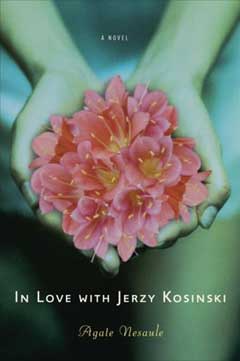
Fans of Agate Nesaule’s 1995 memoir A Woman in Amber have been eagerly awaiting her first novel. Now, 13 years after her memoir received an American Book Award and international praise, it has arrived.
In Love with Jerzy Kosinski explores some of the same issues as A Woman in Amber in a fictional context: immigration, exile and the search for an authentic self after the trauma of war. It’s the story of Anna Dūja, an immigrant to America who escaped from Latvia as a child during the Second World War. Now 43, Anna finds herself in a trap largely of her own devising.
Anna is married to Stanley, an occasionally charming but manipulative Polish-American man. It’s a relationship that is at best disappointing. Stanley undermines Anna‘s self-esteem by offering a punishing kind of love, and the assurance that no one else could ever love her.
She finds solace in an imaginary love affair with the novelist Jerzy Kosinski, author of The Painted Bird, a book Anna reveres. (In A Woman in Amber, Nesaule described teaching this book to her American students.) Kosinski, she feels, is someone who could understand her fractured past, her post-traumatic present. They could comfort each other.
But even in her fantasies Anna has to admit that it’s unlikely that she could ever encounter the glamorous Kosinski in the northern Wisconsin countryside where she and Stanley live. Anna’s feelings of isolation there are reinforced by the fact that she can’t drive and must rely on Stanley or her neighbors to go anywhere.
Into the lake of her discontent Anna drops a tiny pebble: she learns how to drive.
The ripple effect is far reaching. One act leads to another, and eventually to the demise of Anna’s marriage. Though she remains susceptible to Stanley’s guilt-mongering and attacks on her self-worth, she begins to act in her own defence and on her own behalf, sometimes in surprisingly vigorous ways.
Once established in her own apartment, Anna must deal with the usual struggles of a newly single middle-aged woman and face the challenges of anxiety and loneliness. She longs for companionship, for love. Her neighbor Molly tells her: “In real life it’s always women who find men. Always. So let’s get busy.” Nesaule doesn’t shrink from detailing the discrepancies between feminist beliefs and female actions and longings.
Here the novel flirts with the outlines of what can almost be called a genre: the middle-aged woman who leaves an unsatisfying marriage to find herself. Thus we are not surprised when a younger lover shows up in Anna’s life, nor that she discovers in her new relationship that the patterns of a lifetime die hard and can sometimes reincarnate in surprising guises.
Perhaps not wishing to retrace territory already covered in A Woman in Amber, Nesaule reveals Anna’s traumatic wartime history in brief, dream-like fragments. She deals more directly with the personal histories of others. One is a Jewish survivor named Sara who becomes a friend (”…did all exiles automatically recognize and respond to each other like this? Did a complex past unite people even when they did not talk about it?”). The other is of course Jerzy Kosinski, whose autobiographical details become increasingly suspect over time. Are the events of The Painted Bird really based on his own experiences, as he once claimed? Or is the book a self-serving betrayal of those who helped him during the war? Are the growing criticisms of him, including accusations of plagiarism, true?
There is a book that Anna keeps hoping Jerzy Kosinski will write, one that will illuminate her own story as well as the stories of others. It will explain what happens when you live on the edge of war, even if you’re not one of its direct victims. When, in a line of stalled traffic, she hears that Kosinski has committed suicide, Anna thinks she knows why: “He was a child during the war: he was one of the hunted; he was one of the millions marked for death.”
One of the questions Nesaule asks in In Love with Jerzy Kosinski is about the purpose of retelling all the different narratives of suffering, of victimhood. What is the point of reliving these stories, of telling them? She comes up with a tentative possibility: “Maybe instead of clashing and competing, all the stories will weave together into a great tapestry, each thread part of an intricate, somber pattern. Maybe tenderness will prevail.”
Through her stubborn, almost unconscious quest for happiness, in the end Anna learns to have some tenderness, some compassion for herself as well. She finally manages to extricate her fate from that of the beloved Jerzy, “her idol, her soul mate, but not her twin.”
I wondered about Anna’s last name, Dūja. It wasn’t a word I recognized. My Latvian-English dictionary translated it as both “pigeon” and “dove.” In fact the two birds are close relatives and belong to the same family. Both have mournful songs and tend to build relatively flimsy nests, often in insecure places. But they are the strongest fliers of all birds, and are highly manoeuvrable in flight.
Details
In Love with Jerzy Kosinski
Agate Nesaule
Madison, Wis.: University of Wisconsin Press, 2009
ISBN 978-0-299-23130-9
Where to buy
Purchase In Love with Jerzy Kosinski from Amazon.com.
Note: Latvians Online receives a commission on purchases.
© 1995-2024 Latvians Online
Please contact us for editorial queries, or for permission to republish material. Disclaimer: The content of Web sites to which Latvians Online provides links does not necessarily reflect the opinion of Latvians Online, its staff or its sponsors.




